After Monday’s post about enjoying caving, let’s have a lava caving story.
In the UK, if you’re going to crawl around in a hole in the ground, it’ll be a limestone one formed by water action. It’ll have a certain smell, similar to petrichor, you might find fossils and it’ll probably have a mixture of narrow winding passages and big drops.
Iceland doesn’t have limestone. It’s made entirely of volcanic rocks, which are igneous rather than sedimentary and the caves that form in it have very different characteristics. Imagine a river of lava running across the landscape, glowing red and orange, with blackened chunks of half-melted rock floating in it, grinding and clonking against other chunks. Now imagine that Iceland is a cold damp island in the North Atlantic, which is precisely true. Even lava will respond to that eventually and it’ll cool and solidify. It’ll do it from the surface down, since the surface is the bit in direct contact with the miserable weather.

Sometimes the surface solidifies and the liquid lava underneath drains away. That leaves a nice round smooth-ish tunnel and people like me can go and crawl around in them.
Any lava tunnel cool enough to crawl in has got to be several hundred years old, if not a few thousand. The lava behind Landmannalaugar is four or five hundred years old and still hot enough to heat the hot spring. So the tunnels have had a long time to settle. Some of them have collapsed. The ceilings can be thin and fragile and prone to falling in, which is why you’ll find shallow bowls in the landscape, filled with rubble. Other caves have toxic volcanic gases trapped in them, which is why you should always go with an expert guide into a cave they know well.
And so to Leiðarendi.
West of Reykjavik and south of Hafnarfjörður is the vast expanse of the Reykjanes peninsula, a lava field that’s been rumbling and threatening for the last year or two. If you drive up to the foot of the mountains, there’s a hole in the ground called Journey’s End. I’ve been there twice, in winter, on two lava caving trips with two very different companies. Up here, Iceland really is a big white nothing. It makes for some good photos but it also means I have no idea where the cave entrance is.

We were dressed in heavy duty cotton boilersuits – oh, how could I have forgotten that they’re radioactive orange? – and we’d been advised to wear good walking boots and we were equipped with a flimsy plastic hard hat and headlight. At least, we were the first time. On my second trip, I just wore my own coat and we were given a Maglite. I’m not a big fan of that style of torch. I think the light-to-inconvenience ratio is far too low. They weigh a ton, they take enormous batteries (well, they did last time I acknowledged their existence), they occupy a quarter of your available limbs at all times, they’re ludicrously expensive and they’re not even especially bright. To be fair, they do make great blunt weapons.

Dressed thusly, we made our way through the snow to where our guide knew there was a hole in the snow. Descent was easy – snow piled in the entrance made a nice ramp down, if one with a low ceiling. When I caved at uni, we’d all stop, sit down and turn off the lights as soon as we were out of sight of the entrance. It speeds up the process of acclimatising to the complete darkness. But guided groups don’t often have time for that little ritual. Matthias, my guide the first time, sat us down fairly early on to explain the caves and the stories surrounding them – the infamous occasion when I decided to be the enthusiastic and attentive pupil who answered the questions and said “They burn!” to “What happens to a troll when the sun comes up?” Matthias pointed out that I was thinking of vampires. Trolls turn to stone, which is why Iceland has so many weird and wonderful rock formations. They’re all trolls.

I’d somehow expected a lava tube to be absolutely smooth and metallic and perfectly round and to look, in short, like a torpedo tube. But up close, lava caving wasn’t all that dramatically different from limestone caving, except lacking the 3D element. Occasionally passages went off to the sides and sometimes it sloped up or down but it remained resolutely on one level, which you’d expect. The walls had formations – not caused by calcium deposited by water drips but presumably just from leftover lava dripping as it dried. Most of it was a similar shade of brown to a Mendip cave but sometimes we’d come across a patch of brilliant red left by a particularly strong bit of iron and where it was reasonably smooth, the rock gleamed in a dull metallic way, the sort of gleam you get from pearlescent paints.
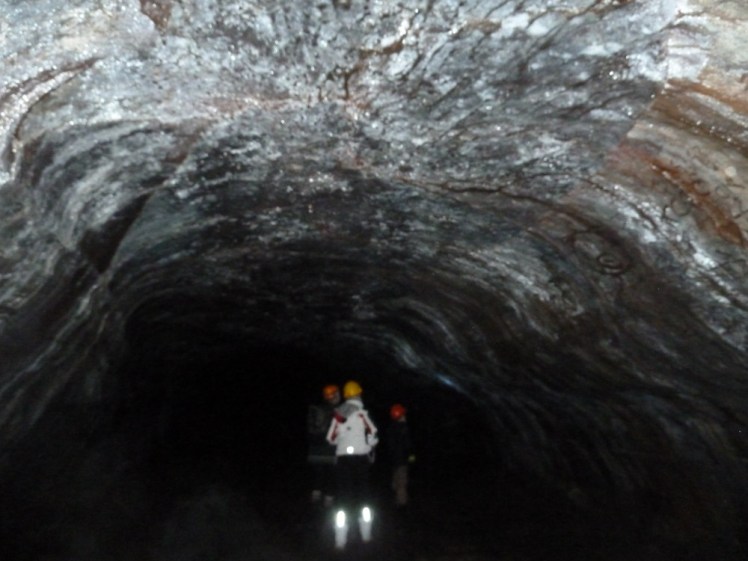
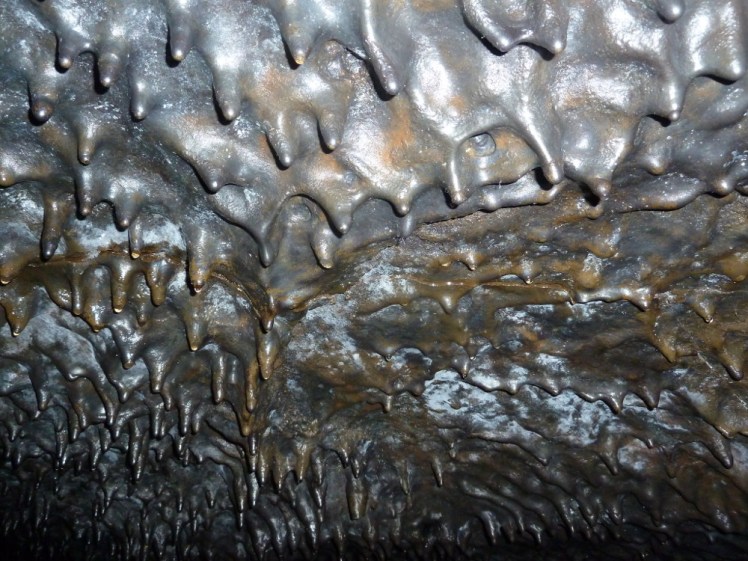

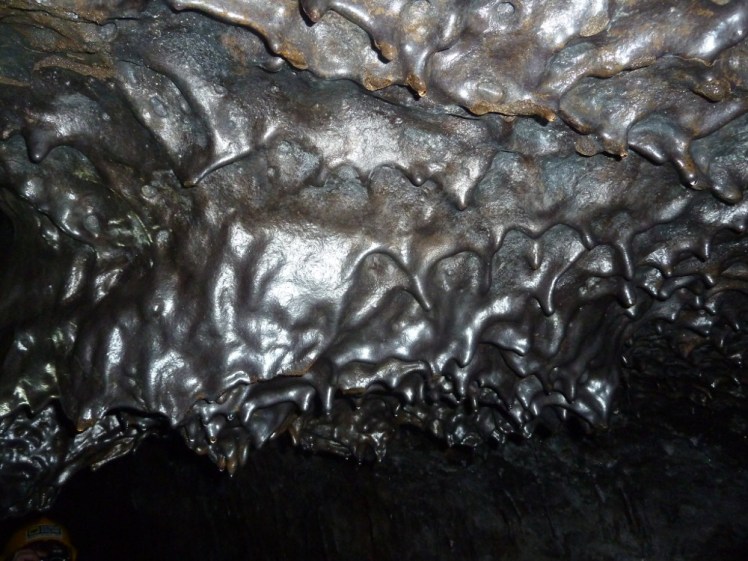
There were even stalactites and stalagmites of a kind where the lava had dropped from the ceiling rather than down the walls. Most prominent were long sharp icicles. Lava isn’t supposed to hold water. That’s why lakes and puddles on lava fields are rare: the water runs through, down to the water table below, down to where it can be heated and brought up to the surface as steam at boreholes. It doesn’t form rivers at cave level and carve its way through the underground until it reaches a surface river it can join as a spring. But it does run down and it had frozen.
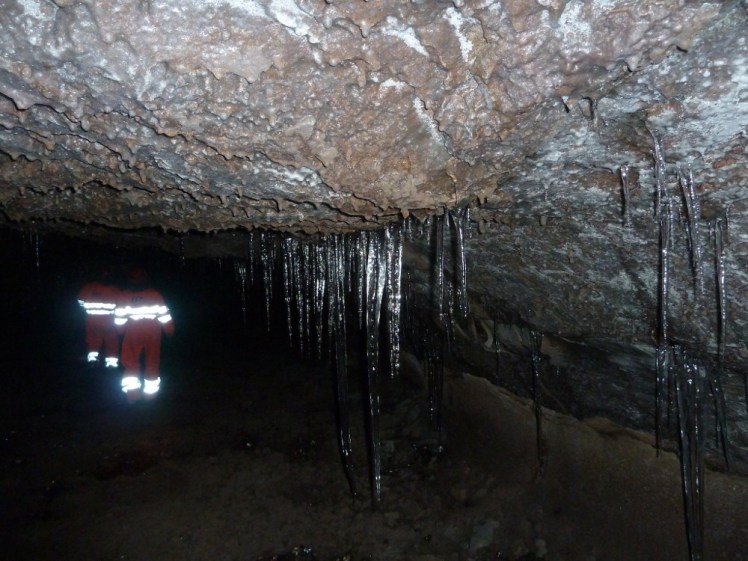
In the UK, caves are a constant temperature of around 8°C, so the seasons don’t make as much impacting what you wear underground as the presence of a streamway does. Apparently the kind of lava caves tourists go into hover around 4°C but the presence of those icicles says it gets lower. Fiendish things. I’ve been taught never ever to damage formations and never even to touch them, as that causes damage that looks less obvious than smashing them but can be just as destructive. So it hurt part of my soul that I couldn’t seem to avoid smashing icicles. I know how quickly and easily they’ll grow back; these aren’t the work of several thousand years but I don’t like breaking things.

At the end of the cave lay a skeleton. A sheep, which had somehow made its way in and never wandered out. Or perhaps fallen in – I don’t know what the entrance looks like when it hasn’t got a snow ramp in it. The sheep is what gave Leiðarendi its name – Journey’s End.

We stopped too, turned and headed back, smashing more icicles as we went. Our guide the second time – yes, Extreme Iceland, I do name you – encouraged the group to write their names in the slime on the wall. In case you thought this was harmless cave art, she showed us where she wrote her name as a child thirty or forty years ago. Do not desecrate caves, or any rocks, in this way, you egotistical morons. That kind of behaviour would get you shunned by the entire caving community here, and Iceland takes its nature preservation more seriously than we do.
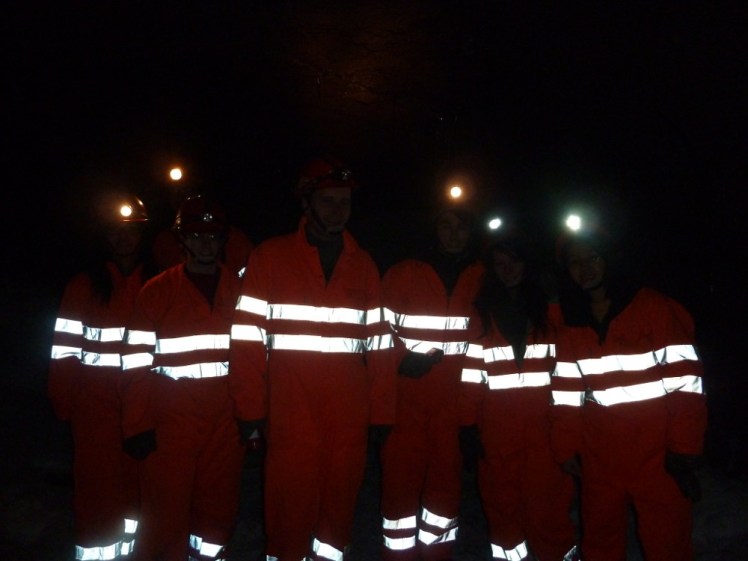

We climbed back out of the hole and emerged from a black tunnel to the pink and blue light of an Arctic winter afternoon in a big white nothing. Where was the minibus? Matthias knew. Good thing, because I had no idea.
If you’re interested in doing a lava caving tour like this yourself (and yes, you do need a pro to lead you), I can find plenty of tours but they seem to use Raufarholshellir and Leiðarendi interchangeably in their descriptions. I’m 98% sure they’re different caves. Raufarholshellir has walkways and railings and is being protected from tourist damage, so it’s less “wild caving” but I’ve seen a description of Leiðarendi as “pitch-dark tube that opens into wide and high hallways”, which I definitely didn’t see. That makes me wonder if Leiðarendi has been enlarged or whether it joins to Raufarholshellir. When the world opens up again, I’ll do one of the tours and let you know.